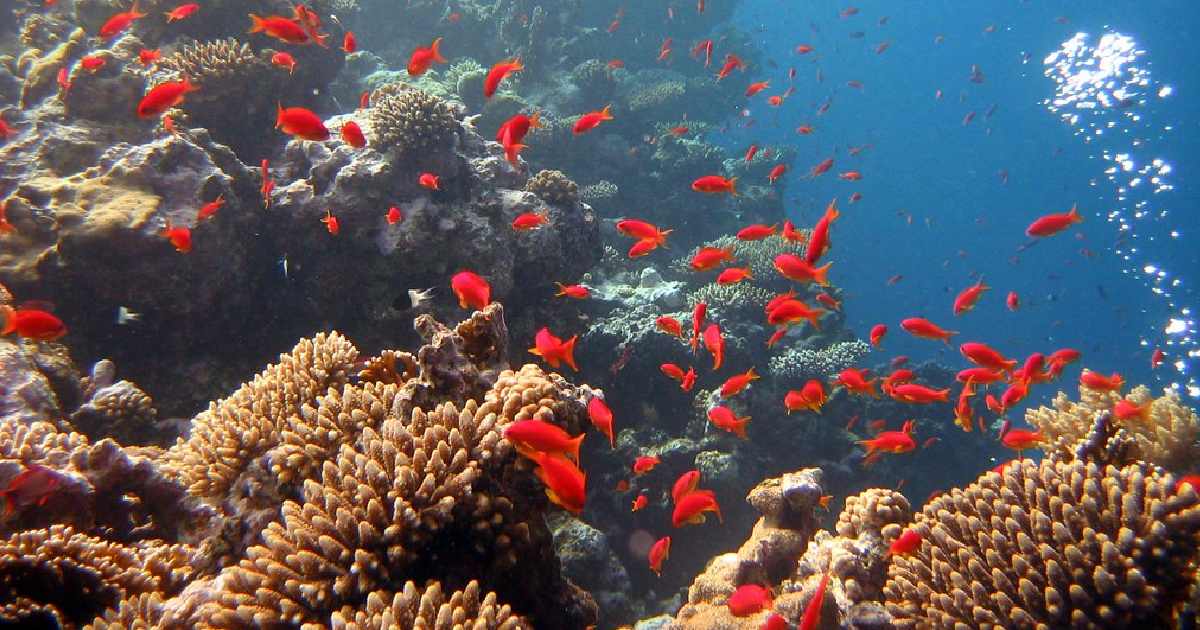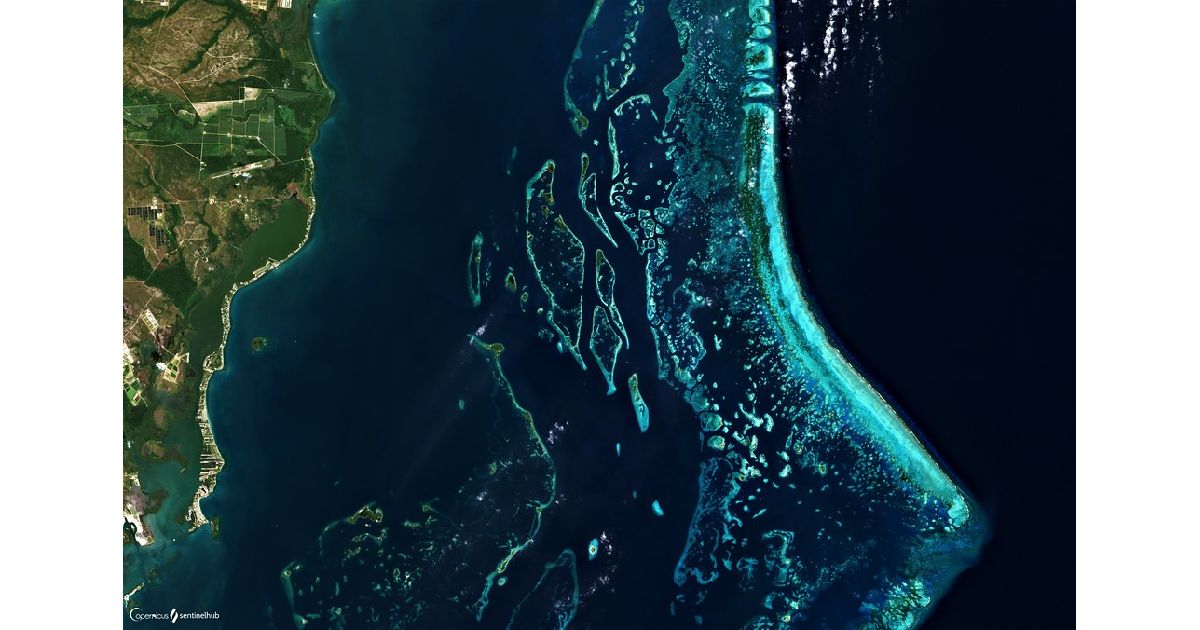Among the world’s fastest-growing and most varied ecological systems are coral reefs. They supply vital aid to coastal villages while sustaining a vast marine fauna. Other than being breathtakingly beautiful, the world’s largest coral reefs are also essential for the overall wellness of the world’s oceans. This article describes the world’s greatest coral reefs, their distinctive attributes, and their state of health, emphasizing their relevance and sustainability.
10. Mesoamerican Reef

- Location: the Atlantic Ocean, along the coast of Mexico, Belize, Guatemala, and Honduras
- Current Health: Vulnerable, impacted by human activity
- Key Features: Largest reef system in the Atlantic Ocean
Together with Mexico, Belize, Guatemala, and Honduras, the Mesoamerican Reef is the largest coral reef structure in the Atlantic Ocean. It runs for more than 600 miles. The coral green spaces, whale sharks, and a variety of fish in this aquatic system are remarkably picturesque. Community members depend on it for tourism, boating, and coastline safeguarding.
However, pollution, over-fish, and global warming endanger the Mesoamerican Reef. Nongovernmental organizations (NGO administrations and local citizens are working to safeguard and restore the reef. Effective conservation and management are vital to the Mesoamerican Reef’s sustainability.
9. Ningaloo Reef, Western Australia

- Location: Coral Coast, Western Australia
- Current Health: Healthy, well-managed
- Key Features: World Heritage site
Western Australia’s Coral Coast’s Ningaloo Reef is a UNESCO world heritage reserve. Reefs on the fringes, like Ningaloo, are close to the coast, making diving and swimming feasible. Periodic whale shark expeditions attract tourists from all over the globe who want to spend time with these gentle sharks.
Environmental supervision and preservation measures will keep Ningaloo’s health quite secure. Aquatic animals like marine turtles, manta rays, and beautiful coral species thrive in the reef. Ningaloo needs to be conserved as an important biodiversity, social to cultural, and economic aid.
8. Tubbataha Reef, Philippines

- Location: Sulu Sea, Philippines
- Current Health: Well-protected, healthy
- Key Features: UNESCO World Heritage site
The UNESCO World Heritage site Tubbataha Reef is located in the Philippines’ Sulu Sea. Its pristine conditions and extensive ecology feed around 600 species and 360 varieties of corals. Coral turtles, whale sharks, and stingrays dominate this distant reef system, making it a paradise for explorers.
A status of protection and committed conservation officers and the Department of Environment and Natural Resources maintain Tubbataha alive. This reef has become the world’s best-preserved owing to rigid regulations and relentless implementation. Filipino and multinational conservation of marine life have been modelled after Tubbataha.
7. Maldives Coral Reef

- Location: Indian Ocean, Maldives
- Current Health: Vulnerable, recovering from bleaching
- Key Features: Coral atolls, luxury dive resorts
The world-renowned coral gardens and rich dive destinations bring travelers to the Maldives Coral Reef complex. The reefs found in the Indian Ocean are home to stingray rays, whale sharks, and exceptional corals. Explorers love the Maldives’ lovely oceans and unique aquatic conditions.
Coral bleaching has ravaged the Maldives’ reef systems triggered by global warming. Advocacy of sustainable tourism and conservation efforts aids in the restoration and protection of these at-risk ecosystems. Global efforts to mitigate climate change and warming oceans will influence the Maldives’ reef biodiversity.
6. Red Sea Coral Reef

- Location: Red Sea, Egypt and Sudan
- Current Health: Relatively stable, resilient to bleaching
- Key Features: High salinity, unique coral species
Egyptian and Sudanese shores possess several of the globe’s oldest varieties of coral in the Red Sea Coral Reef. The reef’s extreme salinity and unusual environment attract vivid corals, turtles, sharks, and massive migratory fish. Prominent diving spots like Ras Mohammed Marine Park feature magnificent marine scenery.
Coral reefs in the Red Sea endured bleaching waves despite rising temperatures. Research attention relies on their exceptional capacity for severe temperatures and salinity. Fostering these substantial environments may help elucidate coral survival in an increasingly warm climate.
5. Palau, Micronesia

- Location: Western Pacific Ocean, Micronesia
- Current Health: Well-managed, resilient
- Key Features: Unique reef and island morphologies
Distinct reef and island contours make Palau’s coral reefs an intricate and diverse aquatic scenario. Marine life, such as ocean turtles, manta rays, and coral plants, grows on Palau’s Western Pacific Ocean reefs. Palau is well-known for its extensive ecological initiatives, especially its gigantic marine haven.
Local and multinational regulations have kept Palau’s reefs alive. The nation has consistently addressed pollution and overfishing, ensuring coral reef adaptability. Such efforts make Palau a shining example of the manner in which conservation and management can safeguard marine riches.
4. Raja Ampat, Indonesia

- Location: West Papua, Indonesia
- Current Health: Relatively healthy, well-preserved
- Key Features: High biodiversity, over 600 species of coral
With respect to biological diversity, Raja Ampat is the globe’s most varied ocean territory. There are approximately 600 varieties of coral and 1,400 categories of fish in the reef system in West Papua, Indonesia. Waters with temperatures perfect for diving and extensive coral reefs attract divers traveling all around the world.
Local efforts to preserve and responsible tourism have maintained Raja Ampat reefs flourishing. International coral reef conservation has been patterned after this region’s remote and safeguarded status, which helped keep its outstanding biodiversity. Raja Ampat’s scenic beauty and ongoing sustainable preservation efforts captivate people.
3. New Caledonia Barrier Reef

- Location: Coral Sea, New Caledonia
- Current Health: Relatively healthy, under threat from climate change
- Key Features: Extensive lagoon system
Among the largest is the Barrier Reef of New Caledonia, situated off the coast of New Caledonia in the Coral Sea. The sea turtles and vibrant coral fish thrive in this 1,500-kilometer reef system’s lagoon chain. Its unspoiled surroundings and abundant aquatic inhabitants draw scuba divers and swimmers.
The barrier reef is healthy, but global warming threatens to bleach coral and acidify the oceans. Each barrier reef is being closely monitored and conserved to preserve its distinct nature. This treasure, the New Caledonia Barrier Reef, requires regular maintenance.
2. Belize Barrier Reef, Belize

- Location: Atlantic Ocean, off the coast of Belize
- Current Health: Recovering, removed from UNESCO’s endangered list
- Key Features: Part of the Mesoamerican Reef
The Mesoamerican Reef features the continent’s second-biggest coral reef system, the Belize Barrier Reef. It supports many aquatic organisms, notably gentle giant whale sharks, around Belize’s coast. Coral landscapes and the underwater world draw snorkelers and divers to the reef.
UNESCO eliminated the reef from its restricted list in 2018 in recognition of Belize’s government and residents’ efforts to preserve it. This essential environment requires constant surveillance to thrive. A noteworthy ecological asset, the Belize Barrier Reef exemplifies the successful preservation of marine life and conservation.
1. Great Barrier Reef, Australia

- Location: North east coast of Australia
- Current Health: Endangered, facing coral bleaching
- Key Features: Largest coral reef system
The Great Barrier Reef, the world’s largest coral reef system, stretches 1,400 miles across Australia’s northeast coast. It comprises one of the most ventured ecosystems on Earth, containing thousands of inhabitants like turtles, whale sharks, and exceptional corals. Scuba diving and scientific study are prevalent at the Great Barrier Reef Marine Park, recognized by UNESCO as a World Heritage Site.
Environmental degradation, bleaching of corals, and contamination imperil the Great Barrier Reef. The coral loss continues to be severe on the reef amid conservation efforts. In light of its vast marine life and vitality to global ocean health, this ecological treasure must be properly conserved.
Conclusion
The world’s largest coral reefs are treasures that nurture extraordinary aquatic creatures and provide essential advantages to humankind. Extreme changes in the climate, emissions, and habitat destruction threaten these undersea marvels, from the Great Barrier Reef in Australia to the Mesoamerican Reef. Maintaining these weakened habitats is a global obligation. By understanding and engaging, people may protect these marvels of nature for the next generation.
Frequently Asked Questions (FAQs)
Where are the biggest coral reefs in the world?
The biggest coral reefs in the world are located in the Great Barrier Reef Marine Park, off the northeast coast of Australia. Spanning over 1,400 miles, this UNESCO World Heritage Site is the largest coral reef system on Earth. It hosts over 2,900 individual reefs and 900 islands, making it a vital habitat for diverse marine life.
What are the 2nd biggest coral reefs in the world?
The second biggest coral reef in the world is the Belize Barrier Reef, part of the Mesoamerican Reef system, stretching over 190 miles off the coast of Belize in the Caribbean Sea. This reef system is known for its rich biodiversity and vibrant coral formations, making it a UNESCO World Heritage Site and a key marine habitat.
What is the largest coral reef in the world that is also dying?
The Great Barrier Reef in Australia is the largest coral reef in the world and is currently experiencing a significant decline. Climate change, coral bleaching, and pollution are major threats to its health, leading to extensive damage over recent decades. Conservation efforts are ongoing to protect and restore this vital ecosystem.
Which country has the best coral reefs?
Australia is often considered to have the best coral reefs, particularly due to the Great Barrier Reef, the largest coral reef system in the world. Other countries like Indonesia (Raja Ampat), the Philippines (Tubbataha Reef), and the Maldives also boast stunning, biodiverse coral reefs that attract divers and marine enthusiasts globally.
Which ocean has the most coral reefs?
The Pacific Ocean has the most coral reefs, including the Great Barrier Reef, Raja Ampat, and the New Caledonia Barrier Reef. It is home to over 75% of the world’s coral species, offering a diverse range of marine habitats. The warm, tropical waters of the Pacific provide ideal conditions for coral growth and biodiversity.

